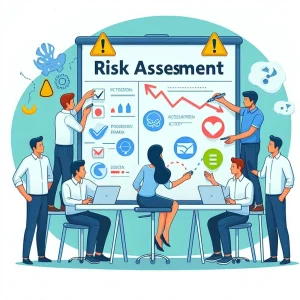Introduction
In today’s complex financial landscape, compliance with regulatory standards is not just a matter of legal obligation but also a critical component of risk management and organizational integrity. Two prominent frameworks that finance professionals must navigate are SOC 2 and SOX.
What is SOC 2?
The SOC 2 framework is a set of standards designed to help service organizations manage customer data securely and effectively. It is particularly relevant for companies that provide technology services, such as Software as a Service (SaaS) providers, where the handling of sensitive customer information is paramount. Here are the key aspects of the SOC 2 framework:
- Overview of the SOC 2 Framework: SOC 2, or Service Organization Control 2, is based on the Trust Services Criteria (TSC) established by the American Institute of CPAs (AICPA). The framework focuses on five key areas: security, availability, processing integrity, confidentiality, and privacy. These criteria ensure that service organizations implement effective controls to protect customer data and maintain trust with their clients.
- Relevance for SaaS and Technology Companies: For SaaS and technology companies, SOC 2 compliance is crucial as it demonstrates a commitment to data security and operational excellence. Given the increasing reliance on cloud services and digital solutions, customers are more likely to choose providers that can prove their adherence to stringent security standards. A SOC 2 report can serve as a competitive differentiator, showcasing a company’s dedication to safeguarding client information.
- Importance of Data Security, Confidentiality, and Privacy: In today’s digital landscape, data breaches and privacy concerns are prevalent. SOC 2 emphasizes the importance of implementing robust security measures to protect sensitive information from unauthorized access and breaches. By adhering to the SOC 2 framework, organizations can ensure that they are not only compliant with industry standards but also fostering trust with their customers. This is particularly vital for CFOs and finance professionals, as the financial implications of data breaches can be significant, affecting both the bottom line and the company’s reputation.
Overview of the SOC 2 Framework: SOC 2, or Service Organization Control 2, is based on the Trust Services Criteria (TSC) established by the American Institute of CPAs (AICPA). The framework focuses on five key areas: security, availability, processing integrity, confidentiality, and privacy. These criteria ensure that service organizations implement effective controls to protect customer data and maintain trust with their clients.
Relevance for SaaS and Technology Companies: For SaaS and technology companies, SOC 2 compliance is crucial as it demonstrates a commitment to data security and operational excellence. Given the increasing reliance on cloud services and digital solutions, customers are more likely to choose providers that can prove their adherence to stringent security standards. A SOC 2 report can serve as a competitive differentiator, showcasing a company’s dedication to safeguarding client information.
Importance of Data Security, Confidentiality, and Privacy: In today’s digital landscape, data breaches and privacy concerns are prevalent. SOC 2 emphasizes the importance of implementing robust security measures to protect sensitive information from unauthorized access and breaches. By adhering to the SOC 2 framework, organizations can ensure that they are not only compliant with industry standards but also fostering trust with their customers. This is particularly vital for CFOs and finance professionals, as the financial implications of data breaches can be significant, affecting both the bottom line and the company’s reputation.
In summary, understanding the SOC 2 framework is essential for CFOs and finance professionals, especially in the context of compliance and risk management. By prioritizing data security, confidentiality, and privacy, organizations can not only meet regulatory requirements but also enhance their overall business resilience and customer trust.
What is SOX?
The Sarbanes-Oxley Act (SOX), enacted in 2002, is a pivotal piece of legislation aimed at enhancing corporate governance and accountability in the wake of significant financial scandals that shook investor confidence. The primary purpose of SOX is to protect investors by improving the accuracy and reliability of corporate disclosures made pursuant to the securities laws. This act mandates strict reforms to enhance financial transparency and prevent corporate fraud, thereby restoring trust in the financial markets [1][10].
Key Requirements for Financial Reporting and Internal Controls
SOX imposes several critical requirements on public companies, particularly concerning financial reporting and internal controls:
- Certification of Financial Statements: One of the cornerstone provisions of SOX is Section 302, which requires that the Chief Executive Officer (CEO) and Chief Financial Officer (CFO) personally certify the accuracy of financial statements. This accountability ensures that top executives are directly responsible for the integrity of financial reporting [3][12].
- Establishment of Internal Controls: Companies must implement robust internal controls to detect and prevent fraud. This includes regular assessments of the effectiveness of these controls, as outlined in Section 404. The requirement for an annual report on internal control effectiveness adds an additional layer of scrutiny to financial reporting processes [1][6].
- Audit Oversight: SOX also mandates that public companies undergo regular audits by external auditors, who must be independent from the company. This oversight is crucial for ensuring that financial statements are free from material misstatements and that internal controls are functioning as intended [12][8].
Certification of Financial Statements: One of the cornerstone provisions of SOX is Section 302, which requires that the Chief Executive Officer (CEO) and Chief Financial Officer (CFO) personally certify the accuracy of financial statements. This accountability ensures that top executives are directly responsible for the integrity of financial reporting [3][12].
Establishment of Internal Controls: Companies must implement robust internal controls to detect and prevent fraud. This includes regular assessments of the effectiveness of these controls, as outlined in Section 404. The requirement for an annual report on internal control effectiveness adds an additional layer of scrutiny to financial reporting processes [1][6].
Audit Oversight: SOX also mandates that public companies undergo regular audits by external auditors, who must be independent from the company. This oversight is crucial for ensuring that financial statements are free from material misstatements and that internal controls are functioning as intended [12][8].
Penalties for Non-Compliance and Its Impact on Public Companies
The implications of non-compliance with SOX are severe and can have significant financial repercussions for public companies:
- Financial Penalties: Companies that fail to comply with SOX can face hefty fines, which can reach millions of dollars. Additionally, individual executives may also face personal fines and even imprisonment for fraudulent activities or for failing to certify accurate financial statements [9][12].
- Reputational Damage: Beyond financial penalties, non-compliance can lead to a loss of investor confidence and damage to a company’s reputation. This can result in decreased stock prices and a loss of business opportunities, as stakeholders may be hesitant to engage with companies that have a history of compliance issues [10][9].
- Increased Scrutiny and Costs: Non-compliance can lead to increased scrutiny from regulators, resulting in more frequent audits and higher compliance costs. Companies may need to invest significantly in compliance programs and internal controls to avoid penalties, which can strain financial resources [6][12].
Financial Penalties: Companies that fail to comply with SOX can face hefty fines, which can reach millions of dollars. Additionally, individual executives may also face personal fines and even imprisonment for fraudulent activities or for failing to certify accurate financial statements [9][12].
Reputational Damage: Beyond financial penalties, non-compliance can lead to a loss of investor confidence and damage to a company’s reputation. This can result in decreased stock prices and a loss of business opportunities, as stakeholders may be hesitant to engage with companies that have a history of compliance issues [10][9].
Increased Scrutiny and Costs: Non-compliance can lead to increased scrutiny from regulators, resulting in more frequent audits and higher compliance costs. Companies may need to invest significantly in compliance programs and internal controls to avoid penalties, which can strain financial resources [6][12].
In summary, the Sarbanes-Oxley Act plays a crucial role in shaping the financial landscape for public companies. Understanding its requirements and implications is essential for CFOs and finance professionals, as compliance not only safeguards against legal repercussions but also fosters trust and integrity in financial reporting.
Key Differences Between SOC 2 and SOX
Key Differences Between SOC 2 and SOX
In the realm of compliance, understanding the distinctions between SOC 2 and SOX is crucial for CFOs and finance professionals. Both frameworks serve important roles in ensuring transparency and accountability, but they cater to different needs and audiences. Here are the primary differences:
1. Scope and Focus
- SOC 2: This framework is primarily concerned with data security and the management of customer data. It is based on five Trust Service Criteria: security, availability, processing integrity, confidentiality, and privacy. SOC 2 compliance is essential for service organizations that handle sensitive information, as it demonstrates their commitment to protecting client data and maintaining operational integrity [12][14].
- SOX (Sarbanes-Oxley Act): In contrast, SOX focuses on financial reporting and corporate governance for publicly traded companies. Its primary aim is to enhance the accuracy and reliability of financial disclosures, thereby protecting investors from fraudulent activities. SOX compliance mandates strict internal controls and reporting requirements, ensuring that financial statements are free from errors and misstatements [1][4][14].
2. Target Audiences
- SOC 2: The target audience for SOC 2 includes service organizations, particularly those that provide services to other businesses and handle sensitive data. This framework is particularly relevant for technology companies, cloud service providers, and any organization that processes customer information [10][12].
- SOX: SOX compliance is mandatory for all publicly traded companies in the United States and their auditing firms. It is designed to protect investors by ensuring that these companies adhere to rigorous financial reporting standards. Private companies are generally not required to comply with SOX unless they plan to go public [13][14].
3. Compliance Processes
- SOC 2 Compliance Process: The SOC 2 compliance process involves a formal audit conducted by an independent third-party auditor. This audit assesses the organization’s adherence to the Trust Service Criteria and evaluates the effectiveness of its internal controls related to data security and privacy. The outcome is a SOC 2 report that can be shared with clients to demonstrate compliance and build trust [11][12].
- SOX Compliance Process: The SOX compliance process is more extensive and involves multiple steps, including the establishment of internal controls, regular assessments, and documentation of financial processes. Key provisions of SOX require the CEO and CFO to certify the accuracy of financial statements, and companies must maintain detailed records for a specified period. Non-compliance can lead to severe penalties, including fines and imprisonment for executives [2][8][14].
Financial Implications of SOC 2 Compliance
In the evolving landscape of cybersecurity and data management, understanding the financial implications of compliance frameworks like SOC 2 is crucial for CFOs and finance professionals. This section delves into the costs associated with achieving SOC 2 compliance, the benefits it brings in terms of customer trust and revenue growth, and the long-term financial advantages of enhanced security and data management.
Potential Costs of Achieving SOC 2 Compliance
Achieving SOC 2 compliance involves several costs that organizations must consider:
- Audit Fees: Engaging a third-party auditor to conduct a SOC 2 audit can be a significant expense. The fees vary based on the complexity of the organization and the scope of the audit, but they are a necessary investment to validate compliance [6][10].
- Resource Allocation: Organizations need to allocate time and resources for the audit process. This includes dedicating personnel to prepare for the audit, which can divert attention from other critical business functions [14].
- Technology and Training: Implementing the necessary security technologies and training employees to adhere to compliance standards can incur additional costs. These investments are essential for maintaining a robust security posture and ensuring ongoing compliance [12][14].
Enhancing Customer Trust and Revenue Growth
One of the most significant benefits of SOC 2 compliance is the enhancement of customer trust:
- Building Credibility: By demonstrating a commitment to data security and privacy, organizations can significantly increase their credibility in the eyes of customers. This trust is vital for attracting and retaining clients, ultimately leading to increased customer lifetime value [5][9].
- Competitive Advantage: In a market where data breaches are increasingly common, having SOC 2 compliance can serve as a competitive differentiator. Organizations that can showcase their commitment to security are more likely to win new business and retain existing customers, thereby driving revenue growth [5][7].
Long-Term Financial Benefits of Improved Security and Data Management
Investing in SOC 2 compliance not only addresses immediate compliance needs but also offers long-term financial benefits:
- Reduced Risk of Data Breaches: Enhanced security measures reduce the likelihood of data breaches, which can be costly in terms of both financial penalties and reputational damage. By investing in SOC 2 compliance, organizations can mitigate these risks and protect their bottom line [11][15].
- Operational Efficiency: The process of achieving SOC 2 compliance often leads to improved operational efficiencies. Streamlined processes and better data management practices can result in cost savings and increased productivity over time [13][14].
- Strategic Business Decision: Viewing SOC 2 compliance as a strategic investment rather than merely a compliance expense can help CFOs justify the costs. The long-term benefits of enhanced security, improved customer trust, and market opportunities often outweigh the initial and ongoing costs associated with compliance [11][12].
Financial Implications of SOX Compliance
The Sarbanes-Oxley Act (SOX) has significant financial implications for companies, particularly for CFOs and finance professionals who must navigate the complexities of compliance. Understanding these implications is crucial for evaluating the costs and benefits associated with SOX compliance.
Costs of Compliance
- Audit Fees: Companies must engage external auditors to assess their compliance with SOX requirements. These audit fees can be substantial, especially for larger organizations or those with complex financial structures. The costs associated with these audits can strain budgets, particularly for smaller firms that may not have the same financial resources as larger corporations [11].
- Administrative Costs: Compliance with SOX necessitates the implementation of rigorous internal controls and financial reporting processes. This often requires hiring additional staff or investing in technology solutions to ensure accurate reporting and monitoring. The administrative burden can lead to increased operational costs, which may impact overall profitability [11][15].
- Penalties for Non-Compliance: Companies that fail to comply with SOX face significant penalties, including fines and potential legal repercussions. The financial impact of these penalties can be severe, not only affecting the company’s bottom line but also damaging its reputation in the marketplace [11].
Importance of SOX for Investor Confidence and Market Value
SOX plays a critical role in enhancing investor confidence, which is essential for maintaining and increasing market value. By enforcing strict financial reporting standards and internal controls, SOX aims to protect investors from fraudulent activities and ensure the accuracy of financial statements. This increased transparency can lead to:
- Boosted Investor Confidence: Compliance with SOX reassures investors that a company is committed to ethical financial practices and accurate reporting. This confidence can translate into increased investment and higher stock prices, ultimately benefiting the company’s market value [9][12].
- Attracting Investment: Companies that demonstrate strong compliance with SOX may find it easier to attract investment, as investors are more likely to support firms that prioritize transparency and accountability. This can lead to enhanced financial stability and growth opportunities [12].
Impact on Operational Efficiency and Financial Reporting Accuracy
While the costs of compliance can be burdensome, SOX also has the potential to improve operational efficiency and the accuracy of financial reporting:
- Enhanced Internal Controls: The requirements of SOX compel companies to establish robust internal controls, which can lead to more efficient operations. By streamlining processes and reducing the risk of errors, organizations can improve their overall financial performance [4][8].
- Improved Financial Reporting Accuracy: SOX mandates that management personally certifies the accuracy of financial statements, which fosters a culture of accountability. This requirement can lead to more diligent financial reporting practices, reducing the likelihood of inaccuracies and enhancing the reliability of financial information [10][13].
Choosing the Right Compliance Framework
When it comes to compliance frameworks, CFOs and finance professionals face the critical task of determining which standard best aligns with their organization’s operational and financial objectives. Understanding the differences between SOC 2 and SOX is essential, as each framework serves distinct purposes and has varying implications for financial reporting and internal controls.
Factors to Consider When Choosing Between SOC 2 and SOX
- Nature of Business Operations:
- SOC 2 is primarily focused on service organizations that handle customer data, emphasizing the security, availability, processing integrity, confidentiality, and privacy of that data. It is particularly relevant for technology and cloud service providers.
- SOX (Sarbanes-Oxley Act), on the other hand, is a federal regulation that mandates strict financial reporting and internal control measures for publicly traded companies. It is crucial for organizations that need to ensure the accuracy of their financial statements and protect against fraud.
- Regulatory Requirements:
- Compliance with SOX is mandatory for publicly traded companies in the U.S., requiring CEOs and CFOs to certify the accuracy of financial reports and establish robust internal controls [14]. This can lead to significant financial implications, including potential penalties for non-compliance.
- Stakeholder Expectations:
- Stakeholders, including investors and customers, may have specific expectations regarding compliance. For instance, clients in sectors like finance or healthcare may prioritize SOC 2 compliance to ensure their data is handled securely.
- Conversely, investors in publicly traded companies will expect adherence to SOX to ensure transparency and accountability in financial reporting [14].
Decision-Making Framework for CFOs
To effectively assess which compliance framework is best suited for their organization, CFOs can follow this decision-making framework:
- Assess Business Model:
- Determine whether the organization is a service provider handling sensitive customer data (SOC 2) or a publicly traded entity requiring stringent financial controls (SOX).
- Evaluate Regulatory Obligations:
- Identify any legal requirements that may necessitate compliance with SOX, especially if the organization is publicly traded.
- Consider Stakeholder Needs:
- Engage with stakeholders to understand their expectations regarding compliance and data security.
- Analyze Financial Implications:
- Weigh the costs associated with achieving and maintaining compliance with each framework, including potential penalties for non-compliance with SOX.
- Long-Term Strategy:
- Align the choice of compliance framework with the organization’s long-term strategic goals, considering how compliance can enhance trust and credibility in the market.
Conclusion
In the ever-evolving landscape of financial regulations, understanding the distinctions between SOC 2 and SOX is crucial for CFOs and finance professionals. Both compliance frameworks serve unique purposes and have significant implications for organizations, particularly in terms of financial integrity and operational security.
- Importance of Compliance: For CFOs, compliance is not merely a regulatory obligation; it is a cornerstone of organizational trust and credibility. Adhering to SOC 2 and SOX standards helps ensure that financial reporting is accurate and that the organization maintains robust internal controls. This is essential for safeguarding stakeholder interests and enhancing investor confidence, which can ultimately impact the organization’s financial performance and market reputation [5][6].
- Ongoing Education and Awareness: The financial landscape is continuously changing, and so are the compliance requirements. CFOs should prioritize ongoing education and awareness regarding these frameworks. This includes staying informed about updates to regulations, understanding the implications of non-compliance, and recognizing how these frameworks can be integrated into the organization’s overall risk management strategy. Regular training and workshops can be beneficial in keeping finance teams updated on best practices and compliance strategies [6][12].
Resources for Further Reading and Support: To support your compliance journey, consider leveraging resources such as industry publications, webinars, and professional organizations that focus on internal audit and compliance. Engaging with these resources can provide valuable insights and practical guidance on navigating the complexities of SOC 2 and SOX compliance. Additionally, consulting with compliance experts or auditors can offer tailored advice and support to ensure your organization meets its obligations effectively [8][12].
Find out more about Shaun Stoltz https://www.shaunstoltz.com/about/
This post was written by an AI and reviewed/edited by a human.



